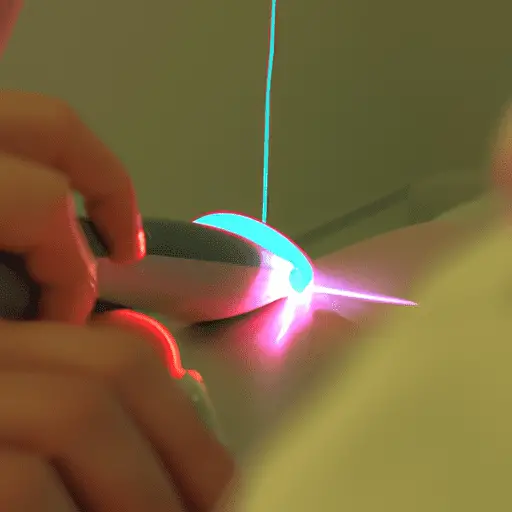Treating venous diseases with laser therapy
-
Table of Contents
- Treating Venous Diseases with Laser Therapy
- Key Takeaways
- Introduction: The Rise of Laser Therapy in Venous Disease Treatment
- The Science Behind Laser Therapy
- Efficacy and Safety of Laser Therapy
- Considerations and Limitations
- FAQ Section
- 1. What types of venous diseases can be treated with laser therapy?
- 2. How long does the procedure take?
- 3. What is the recovery time?
- 4. Are there any side effects?
- 5. Is laser therapy covered by insurance?
- Conclusion: The Future of Venous Disease Treatment
- Key Takeaways Revisited
Treating Venous Diseases with Laser Therapy

[youtubomatic_search]
Key Takeaways
- Laser therapy is a minimally invasive procedure used to treat venous diseases such as varicose veins and spider veins.
- It uses light energy to heat and damage the walls of the diseased vein, causing it to collapse and eventually be reabsorbed by the body.
- Studies have shown that laser therapy is a safe and effective treatment option, with a high success rate and low risk of complications.
- Patients typically experience less pain and a quicker recovery time compared to traditional surgical treatments.
- Despite its benefits, laser therapy may not be suitable for everyone and should be discussed with a healthcare provider.
Introduction: The Rise of Laser Therapy in Venous Disease Treatment
Over the past few decades, the medical field has seen significant advancements in the treatment of venous diseases. One such advancement is the use of laser therapy, a minimally invasive procedure that has revolutionized the way we treat conditions such as varicose veins and spider veins. This article explores the effectiveness of laser therapy in treating venous diseases, its benefits and potential drawbacks, and its role in the future of venous disease treatment.
The Science Behind Laser Therapy
Laser therapy, also known as endovenous laser ablation (EVLA), works by using light energy to heat and damage the walls of the diseased vein. This causes the vein to collapse and eventually be reabsorbed by the body, effectively eliminating the problem. The procedure is performed under local anesthesia and typically takes less than an hour, making it a convenient option for many patients.
Efficacy and Safety of Laser Therapy
Multiple studies have demonstrated the efficacy and safety of laser therapy in treating venous diseases. A 2019 study published in the Journal of Vascular Surgery found that EVLA had a success rate of over 90%, with a low risk of complications such as deep vein thrombosis and skin burns. Furthermore, patients reported less pain and a quicker recovery time compared to traditional surgical treatments.
Considerations and Limitations
Despite its many benefits, laser therapy may not be suitable for everyone. Certain factors, such as the size and location of the vein, the patient’s overall health, and their personal preferences, should be taken into account when considering this treatment option. Additionally, like all medical procedures, laser therapy carries some risk of side effects, including bruising, swelling, and changes in skin color. Therefore, it is important to discuss these potential risks with a healthcare provider before deciding on treatment.
FAQ Section
1. What types of venous diseases can be treated with laser therapy?
Laser therapy can be used to treat a variety of venous diseases, including varicose veins, spider veins, and venous ulcers.
2. How long does the procedure take?
The procedure typically takes less than an hour and can be performed on an outpatient basis.
3. What is the recovery time?
Most patients can return to their normal activities within a few days of the procedure. However, it may take several weeks for the treated vein to fully disappear.
4. Are there any side effects?
Common side effects include bruising, swelling, and changes in skin color. However, these are usually temporary and resolve on their own.
5. Is laser therapy covered by insurance?
Many insurance companies cover laser therapy for venous diseases, but coverage may vary depending on the specific policy and the severity of the condition.
Conclusion: The Future of Venous Disease Treatment
In conclusion, laser therapy represents a significant advancement in the treatment of venous diseases. Its high success rate, low risk of complications, and quick recovery time make it an attractive option for many patients. However, it is not without its limitations and potential risks, and should therefore be considered as part of a comprehensive treatment plan. As research continues and technology advances, we can expect to see further improvements in the safety and efficacy of this promising treatment modality.
Key Takeaways Revisited
- Laser therapy is a minimally invasive, highly effective treatment option for venous diseases.
- The procedure uses light energy to heat and damage the walls of the diseased vein, causing it to collapse and be reabsorbed by the body.
- Studies have shown a high success rate and low risk of complications, making it a safe treatment option.
- Patients typically experience less pain and a quicker recovery time compared to traditional surgical treatments.
- Despite its benefits, laser therapy may not be suitable for everyone and should be discussed with a healthcare provider.
[youtubomatic_search]


